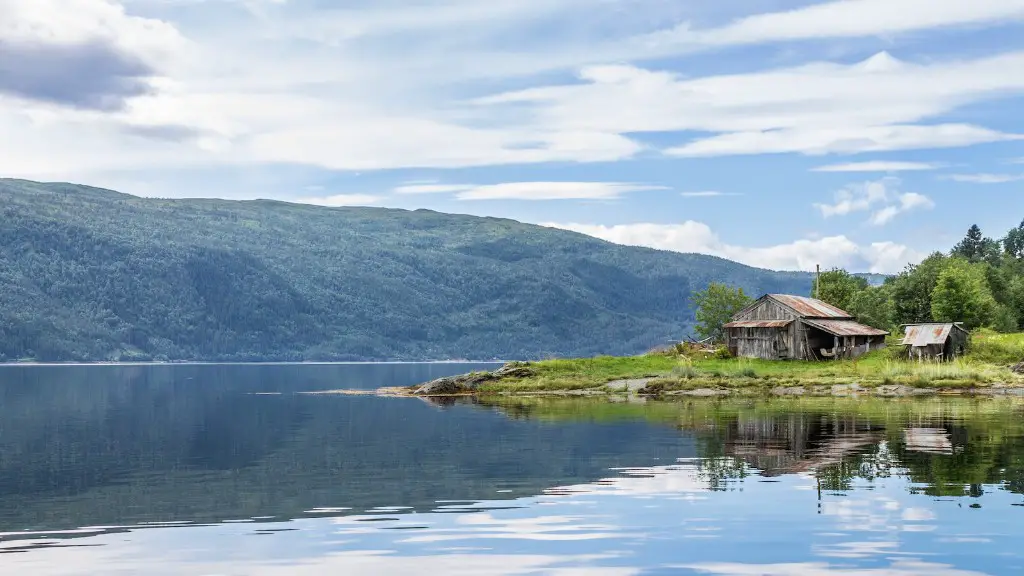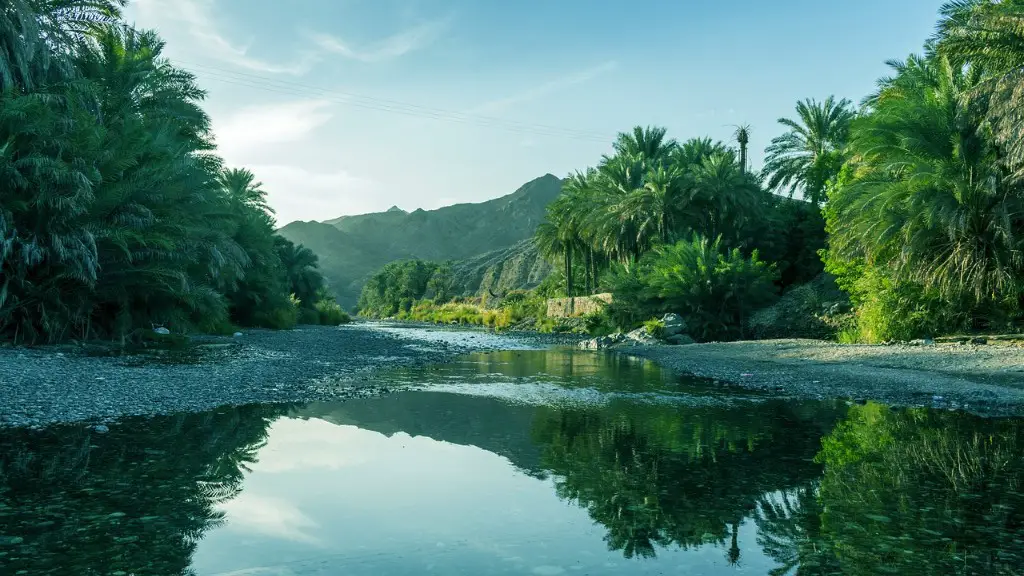The Lower Mississippi River is a great example of both meandering and braided river channels. Along its channel, it undergoes severals changes in behavior and character. It runs for over one thousand kilometers, winding its way through numerous states and regions in the Midwestern United States. The Lower Mississippi River has been the inspiration for countless artists and writers, who have attempted to capture its complexity and beauty. Geographically and geologically, it is a perfect example of a braided and meandering river.
Meandering is the better known behavior of a river. It is the winding shape of its curves, bends and turns. Meandering is a consequence of the erosion of the river banks, the removal of material from the outer bend and the accretion of material on the inner bend of the meander. In a meandering river, the gradient of the side-slope is steep while the gradient of the bottom surface is gentle.
Braided rivers, on the other hand, have a characteristically larger number of stream channels, which divide and re-join as the river progresses downstream. A braided river also experiences frequent changes in its character as the branches move and re-configure. The lateral slopes of braided rivers tend to be more gentle than those of meandering rivers, and their widths greater. Braided rivers tend to be absent of vegetation, as the stream flows are more complex and the water depth more unpredictable.
These two forms of rivers are often seen in the same region and the same river. The Lower Mississippi River, for example, is classified as both meandering and braided in different stretches, as is the upper Mississippi River. The Upper Mississippi River is known for its oxbow lakes, a type of lake that is created by the meandering of a river, while the Lower Mississippi River is characterized by ridge-and-swale topography, which is common in braided rivers. The two forms of rivers are quite different in behavior, but they both play an important role in the health of the river ecosystem.
The differences between the two forms of river can be explained by their relative stages of maturity. Meandering rivers are in a mature stage, with a more stable channel form, fewer channel alterations and less frequent channel shifts. On the other hand, braided rivers are in an immature and dynamic stage, where channel shifts and channel alterations occur frequently. The Lower Mississippi River has both meandering and braided sections, and this is attributed to its varied topography, and the often-sudden changes in its flow rate and sediment load.
Experts suggest that the changes in behavior of the Lower Mississippi River are due to the pressure of human activities. The construction of levees, dams, locks and other impoundments, as well as the clearing of land for agricultural uses, have led to channel incision, increased sediment loads, and reduced floodplain areas for the river. These factors have led to a decrease in the number of meanders and an increase in the number of braided sections. In addition, climate change has also been suggested to have an influence on the river’s behavior, leading to more frequent floods, higher flow velocities, and increased sediment transport, which have all contributed to the changes in the River’s form.
The different behaviors of the Lower Mississippi River present both challenges and opportunities for river management and conservation. Meandering sections of the river can be preserved through river restoration projects aimed at restoring the river’s natural flow regime, while braided sections can benefit from increased connectivity and increased floodplain area to enhance the river’s resilience. Restoring the Lower Mississippi River’s natural meandering and braiding behavior is essential in maintaining the river’s health and preserving its beauty for generations to come.
Resiliance and Adaptation of Lower Mississippi River
The Lower Mississippi River is characterized by its dynamic character and its ability to adapt to challenging conditions. Throughout history, its resilience and its adaptiveness have been intimately linked to its meandering and braided features. These features play an important role in the river’s hydrological, geological, and ecological functioning, which is key for its longevity and productivity.
The Lower Mississippi River has been able to remain resilient despite various man-made alterations to its hydrology and topography. This can be attributed to its meandering and braided character, which have enabled the river to move material downstream and to redistribute sediment according to the energy levels of different stream reaches. This redistribution has meant that the river is better able to withstand the effects of man-made alterations, including the effects of levees and other structural works, while preserving its natural meandering and braiding character.
In addition to its ability to remain resilient, the Lower Mississippi River has also demonstrated its adaptability through its changing behaviour along its channel. As the river progresses downstream, different sections of it become more or less meandering or braided depending on the hydrology, geology, and topography of the channel. This observation suggests that changes in the flow and sediment regime of the Lower Mississippi River have an influence on its channel form. This further cements the link between hydrology and channel morphology and how they interact with each other to create what we see today.
The behavior of the Lower Mississippi River thus lends itself to both resilience and adaptation, and offers a showcase of what can be achieved by river management and conservation. Its meandering and braided sections represent important components of its overall hydrology, geology, and ecology, and serve as a useful model for river management and conservation projects worldwide.
Influence of Climate Change on Lower Mississippi River
The effects of climate change on the Lower Mississippi River are already being felt, and the River is beginning to demonstrate an increased level of variability in its behavior. Recent studies have predicted a decrease of up to 5% in the river’s discharge by the year 2100, due to the effects of climate change. This could lead to substantial changes in the River’s meandering and braided sections due to decreased water depth, increased sediment loads, and altered sedimentation patterns.
Changes in the river’s behaviour due to climate change could have serious implications for the River’s overall economy and biodiversity. Decreased water flows could affect fish and wildlife habitats, as well as the livelihoods of people who rely on the River for fishing and other activities. In addition, increased sedimentation rates due to climate change could lead to increased erosion along the banks of the River, as well as an increase in bank instability and sediment accumulation in Lake Pontchartrain.
Adaptation to climate change is essential in order to maintain the Lower Mississippi River’s health and productivity. Climate change adaptation strategies must seek to restore the River’s natural meandering and braided sections, while ensuring that its hydrology, geology, and ecology are preserved. In addition, strategies must also consider the importance of the River to the local economy and society, and ensure that the River remains productive for future generations.
Riverscaping of Lower Mississippi River
Riverscaping is a form of landscape architecture that seeks to create innovative greenways, parks and riverfront developments along rivers and streams. Riverscaping can be used to create urban riverfronts with multi-functional uses, while preserving the natural meandering and braided sections of the rivers. Riverscaping can also be used to create corridors for conservation and free-flowing river habitats.
Riverscaping projects along the Lower Mississippi River could be used as a means of preserving the River’s natural meandering and braided sections. In addition, riverscaping could create recreational areas along the River, providing opportunities for people to engage with and appreciate the River’s beauty and complexity. Riverscaping is a cost-effective way of preserving the River’s ecological functions, while providing economic and social benefits to the local community.
Riverscaping is a relatively new concept, but it has great potential for restoring the Lower Mississippi River’s natural character. The River’s meandering and braided sections are its defining characteristics, and these need to be preserved and maintained. Riverscaping could be used to create highly functional greenways, parks and riverfront developments, while preserving the River’s natural character and its meandering and braided sections.
Ecosystems of Lower Mississippi River
The Lower Mississippi River is home to a wide range of ecosystems, each of which provides a habitat for numerous species of plants and animals. The River’s meandering and braided sections support a variety of aquatic and terrestrial ecosystems, including wetlands, woodlands and bottomland hardwoods. These ecosystems provide a variety of benefits to the River’s ecology, such as floodwater retention, nutrient and sediment cycling, and the habitat support for numerous species.
The Lower Mississippi River’s meandering and braided sections are also vitally important for a range of aquatic and terrestrial species, providing a habitat for various migratory birds and fish species. The different species that inhabit the River rely on the different channel forms, and the connection of the channel to its associated ecosystems, in order to survive and thrive.
The health and productivity of the Lower Mississippi River is inextricably linked to its meandering and braided sections. It is essential that the river’s natural characteristics are preserved and maintained in order to ensure that the River’s ecosystems remain diverse and productive. The responsibility of protecting the River thus lies with us, and it is up to us to ensure that the River remains healthy and and that its ecosystems remain intact.
Impact of Human Activities on Lower Mississippi River
The Lower Mississippi River is greatly impacted by the various human activities that occur along its length. These activities, such as transportation, agriculture, urbanization, and industrialization, all have an impact on the health and productivity of the River, and its associated ecosystems.
Human activities have impacted the River’s behavior, leading to changes in its meandering and braided sections. These changes can have a negative effect on the River’s health and productivity, as they can lead to increased erosion, sedimentation, and a decrease in the River’s water quality and biodiversity.
It is thus important that human activities are managed in a way that minimizes their impact on the River’s meandering and braided sections. River management and conservation strategies must seek to incorporate the preservation of these sections in order to protect and restore the River’s health and vitality.
In addition, it is also critical that public attitudes towards the Lower Mississippi River are changed and that people are made more aware of the importance of preserving its meandering and braided sections. This can be achieved through public education and engagement programs, as well as through creating and supporting initiatives that aim to preserve the River’s natural flows and channel forms.
Restoration of Lower Mississippi River
Restoration of the Lower Mississippi River is an essential part of preserving its meandering and braided sections. A variety of restoration techniques can be used to restore the River’s natural hydrology, geology, and ecology, while preserving its character and its meandering and braided sections.
River restoration projects, such as the Birds Point-New Madrid floodway project, can have a positive impact on the River’s meandering and braiding features by restoring its natural hydrology, geology, and ecology. Other projects, such as levee removals and river relocation projects, can also have a positive impact on the River by restoring its natural flows and reconnecting it to its floodplain area.
In addition, revegetation projects can be used to restore the River’s meandering and braiding features by creating near-natural vegetation along the banks of the River. This can help to reduce the amount of sediment transported by the River and help to reduce bank erosion. The creation of greenways, parks and other recreational areas can also have a positive impact, as they can help to preserve the River’s beauty and complexity.
Restoration projects along the Lower Mississippi River are an essential part of its conservation and protection. River restoration can help to preserve the River’smeandering and braided sections, while restoring its hydrological, geological, and ecological functions. Restoring the River is thus a vital step in safeguarding its health and productivity for future generations.





